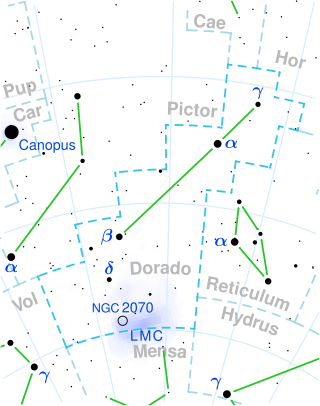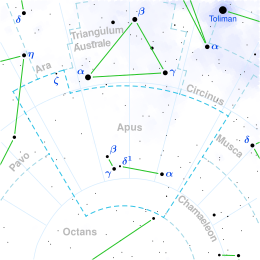
ι Telescopii, Latinized as Iota Telescopii and abbreviated Iota Tel, is a solitary star located in the southern constellation Telescopium. It is faintly visible to the naked eye as an orange-hued star with an apparent visual magnitude of +4.88. The star is located roughly 377 light years distant from the Solar System based on Gaia DR3 parallax measurements and it is receding with a radial velocity of 22.3 km/s. At its current distance, Iota Tel's brightness is diminished by 0.19 magnitudes due to interstellar dust and it has an absolute magnitude of −0.39.

Beta Coronae Australis, Latinized from β Coronae Australis, is a solitary star located in the southern constellation Corona Australis. It is visible to the naked eye as a faint, orange-hued star with an apparent visual magnitude of 4.10. The star is located around 470 light years distant from the Sun based on parallax, and is drifting further away with a radial velocity of 2.7 km/s. At its current distance, Beta CrA's brightness is diminished by 0.29 magnitudes due to interstellar dust.
HD 27274, also known as Gliese 167, is a solitary, orange hued star located in the southern constellation Dorado. It has an apparent magnitude of 7.63, making it readily visible in binoculars, but not to the naked eye. Based on parallax measurements from the Gaia spacecraft, the star is known to be located 42.5 light-years away from the Solar System However, it is drifting closer with a heliocentric radial velocity of −23 km/s. At its current distance, HD 27274 is dimmed down by 0.05 magnitudes due to interstellar dust.

HD 24479, also designated as HR 1204, is a solitary, bluish-white hued star located in the northern circumpolar constellation Camelopardalis. The star is visible to the naked eye with an apparent visual magnitude of 5.04. Based on Gaia DR3 parallax measurements, it is located 385 light years from the Sun. However, it is receding with a somewhat constrained heliocentric radial velocity of 4.6 km/s. At its current distance, HD 24479's brightness is diminished by 0.29 magnitudes due to interstellar dust.

Q Scorpii, also designated as HD 159433, is an astrometric binary located in the southern zodiac constellation Scorpius. It has an apparent magnitude of 4.27, making it readily visible to the naked eye under ideal conditions. It lies in the tail of Scorpius, between the stars λ Scorpii and μ Scorpii and is located 7′ away from the faint globular cluster Tonantzintla 2. Based on parallax measurements from Gaia DR3, the system is estimated to be 158 light years distant, but is approaching the Solar System with a heliocentric radial velocity of −49 km/s.
HD 63399 is an orange hued star located in the southern constellation Puppis, the poop deck. It has an apparent magnitude of 6.45, placing it near the limit for naked eye visibility. Based on parallax measurements from Gaia DR3, the object is estimated to be 445 light years distant. It appears to be receding with a spectroscopic radial velocity of 28.5 km/s. At its current distance, HD 63399 is diminished by 0.29 magnitudes due to interstellar dust.

HD 72922, also known as HR 3393, is a suspected astrometric binary located in the southern circumpolar constellation Chamaeleon. A 1993 paper by Olin J. Eggen lists it as a member of the Milky Way's old disk population.

HD 57197, also known as M Puppis or HR 2789, is a suspected astrometric binary located in the southern constellation Puppis, the poop deck. It has an apparent magnitude of 5.84, making it faintly visible to the naked eye under ideal conditions. Based on parallax measurements from the Gaia satellite, the system is estimated to be 629 light years away from the Solar System. The value is poorly constrained, but it appears to be receding with a heliocentric radial velocity of 13 km/s. At its current distance, HD 57197's brightness is diminished by 0.3 magnitudes due to interstellar dust. It has an absolute magnitude of -0.43.

HD 26764, also known as HR 1314 or rarely 14 H. Camelopardalis, is a solitary white hued star located in the northern circumpolar constellation Camelopardalis. It has an apparent magnitude of 5.19, making it faintly to the naked eye if viewed under good conditions. Gaia DR3 parallax measurements place the object at a distance of 266 light years and is drifting closer with a poorly constrained heliocentric radial velocity of 3 km/s. At its current distance, HD 26764's brightness is diminished by 0.26 magnitudes due to interstellar dust.

Gamma3 Octantis, Latinized from γ3 Octantis, is a solitary star located in the southern circumpolar constellation Octans. It is faintly visible to the naked eye as an orange-hued star with an apparent magnitude of 5.28. The object is located relatively close at a distance of 264 light years but is receding with a heliocentric radial velocity of 15 km/s. At its current distance, Gamma3 Octantis' brightness is diminished by two tenths of a magnitude due to interstellar dust and Eggen (1993) lists it as a member of the old disk population. It has an absolute magnitude of +0.83.

HD 76236, also designated as HR 3543 or rarely 11 G. Chamaeleontis, is a solitary star located in the southern circumpolar constellation Chamaeleon. It is faintly visible to the naked eye as an orange-hued star with an apparent magnitude of 5.77. Based on parallax measurements from the Gaia satellite, the object is estimated to be 612 light years away. Currently, it is receding with a heliocentric radial velocity of 7 km/s. At its current distance, HD 76236's brightness is diminished by 0.39 magnitudes due to interstellar dust. It has an absolute magnitude of −0.13.

14 Trianguli, also known as HD 15656, is a spectroscopic binary located in the northern constellation Triangulum. It has an apparent magnitude of 5.14, making it faintly visible to the naked eye in ideal conditions. Gaia DR3 parallax measurements place the system 433 light years away, and it is currently approaching the Solar System with a heliocentric radial velocity of −37 km/s. At its current distance, 14 Tri's brightness is diminished by 0.21 magnitude due to interstellar dust. It has an absolute magnitude of −0.46.

WZ Columbae, also known as HD 38170, is a solitary, bluish-white hued star located in the southern constellation Columba, the dove. It has an apparent magnitude of 5.28, allowing it to be faintly visible to the naked eye. Based on parallax measurements from the Gaia spacecraft, the object is about 365 light years distant. It appears to be receding from the Solar System, having a heliocentric radial velocity of 36.3 km/s.
HD 43899, also designated as HR 2263, is a solitary, orange hued star located in the southern constellation Columba, the dove. It has an apparent magnitude of 5.53, allowing it to be faintly visible to the naked eye. Based on parallax measurements from the Gaia spacecraft, the object is estimated to be 284 light years distant. It appears to be rapidly receding with a heliocentric radial velocity of 66.5 km/s. Eggen (1993) lists HD 43899 as an old disk star and its kinematics match with that of the ζ Herculis moving group.

HD 198716, also known as HR 7987 or 33 G. Microscopii, is a solitary star located in the southern constellation Microscopium. Eggen (1993) lists it as a member of the Milky Way's old disk population.

HD 197630, also known as HR 7933 or rarely 23 G. Microscopii, is a probable astrometric binary located in the southern constellation Microscopium. The visible component is a bluish-white hued star that is faintly visible to the naked eye with an apparent magnitude of 5.47. Based on parallax measurements from the Gaia satellite, the system is estimated to be 328 light years away. However, it is drifting closer with a heliocentric radial velocity of −30 km/s. At its current distance, HD 197630's brightness is diminished by 0.11 magnitudes due to interstellar dust. A 2012 multiplicity survey failed to confirm the velocity variations.

HD 168592, also designated as HR 6862 or rarely 7 G. Coronae Australis, is a solitary star located in the southern constellation Corona Australis. It is faintly visible to the naked eye as an orange-hued star with an apparent magnitude of 5.07. Gaia DR3 parallax measurements place it at a distance of 490 light years and is currently receding with a heliocentric radial velocity of 18 km/s. At its current distance, HD 168592's brightness is diminished by 0.38 magnitudes due to interstellar dust. It has an absolute magnitude of −0.76.

HD 175219, also known as HR 7122, is a solitary, orange hued star located in the southern constellation Corona Australis. It has an apparent magnitude of 5.35, allowing it to be faintly visible to the naked eye. The object is located relatively close at a distance of 314 light years based on Gaia DR3 parallax measurements but is drifting closer with a heliocentric radial velocity of −21.1 km/s. At its current distance, HD 175219's brightness is diminished by 0.26 magnitudes due to interstellar dust. It has an absolute magnitude of +0.57.

HD 170521, also known as HR 6937 or rarely 12 G. Coronae Australis, is a solitary star located in the southern constellation Corona Australis. It is faintly visible to the naked eye as an orange-hued point of light with an apparent magnitude of 5.69. The object is located relatively far at a distance of approximately 1,500 light years based on Gaia DR3 parallax measurements, and it is receding with a heliocentric radial velocity of 7.2 km/s. At its current distance, HD 170521's brightness is heavily diminished by 0.46 magnitudes due to extinction from interstellar dust and it has an absolute magnitude of −1.90.

Pi2 Doradus, Latinized from π2 Doradus, is a solitary star located in the southern constellation Doradus. It is faintly visible to the naked eye as a yellow-hued point of light with an apparent magnitude of 5.38. The object is located relatively close at a distance of 277 light-years based on Gaia DR3 parallax measurements, but it is receding with a heliocentric radial velocity of approximately 9.1 km/s. At its current distance, Pi2 Doradus' brightness is diminished by 0.27 magnitudes due to interstellar extinction and it has an absolute magnitude of +0.78.











